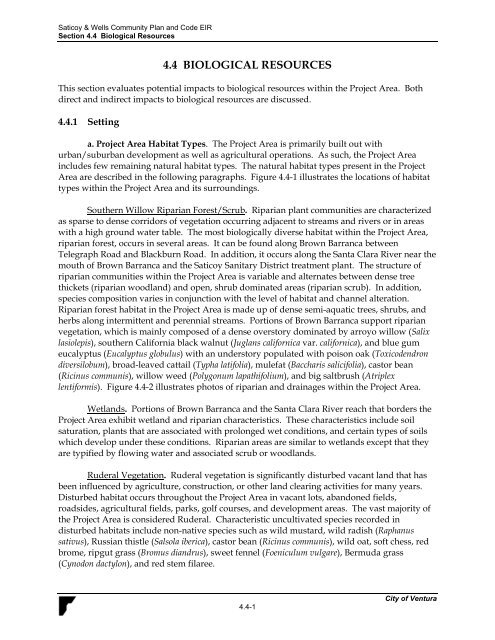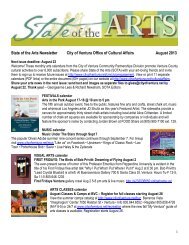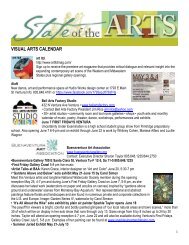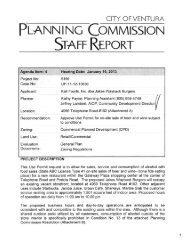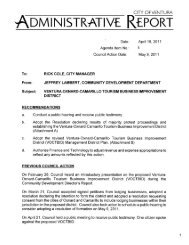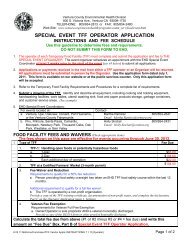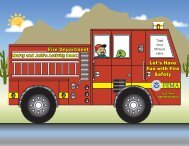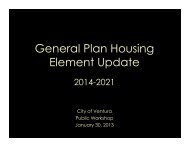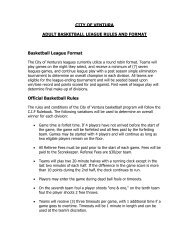Saticoy & Wells Community Plan & Development ... - City Of Ventura
Saticoy & Wells Community Plan & Development ... - City Of Ventura
Saticoy & Wells Community Plan & Development ... - City Of Ventura
Create successful ePaper yourself
Turn your PDF publications into a flip-book with our unique Google optimized e-Paper software.
<strong>Saticoy</strong> & <strong>Wells</strong> <strong>Community</strong> <strong>Plan</strong> and Code EIRSection 4.4 Biological Resources4.4 BIOLOGICAL RESOURCESThis section evaluates potential impacts to biological resources within the Project Area. Bothdirect and indirect impacts to biological resources are discussed.4.4.1 Settinga. Project Area Habitat Types. The Project Area is primarily built out withurban/suburban development as well as agricultural operations. As such, the Project Areaincludes few remaining natural habitat types. The natural habitat types present in the ProjectArea are described in the following paragraphs. Figure 4.4-1 illustrates the locations of habitattypes within the Project Area and its surroundings.Southern Willow Riparian Forest/Scrub. Riparian plant communities are characterizedas sparse to dense corridors of vegetation occurring adjacent to streams and rivers or in areaswith a high ground water table. The most biologically diverse habitat within the Project Area,riparian forest, occurs in several areas. It can be found along Brown Barranca betweenTelegraph Road and Blackburn Road. In addition, it occurs along the Santa Clara River near themouth of Brown Barranca and the <strong>Saticoy</strong> Sanitary District treatment plant. The structure ofriparian communities within the Project Area is variable and alternates between dense treethickets (riparian woodland) and open, shrub dominated areas (riparian scrub). In addition,species composition varies in conjunction with the level of habitat and channel alteration.Riparian forest habitat in the Project Area is made up of dense semi-aquatic trees, shrubs, andherbs along intermittent and perennial streams. Portions of Brown Barranca support riparianvegetation, which is mainly composed of a dense overstory dominated by arroyo willow (Salixlasiolepis), southern California black walnut (Juglans californica var. californica), and blue gumeucalyptus (Eucalyptus globulus) with an understory populated with poison oak (Toxicodendrondiversilobum), broad-leaved cattail (Typha latifolia), mulefat (Baccharis salicifolia), castor bean(Ricinus communis), willow weed (Polygonum lapathifolium), and big saltbrush (Atriplexlentiformis). Figure 4.4-2 illustrates photos of riparian and drainages within the Project Area.Wetlands. Portions of Brown Barranca and the Santa Clara River reach that borders theProject Area exhibit wetland and riparian characteristics. These characteristics include soilsaturation, plants that are associated with prolonged wet conditions, and certain types of soilswhich develop under these conditions. Riparian areas are similar to wetlands except that theyare typified by flowing water and associated scrub or woodlands.Ruderal Vegetation. Ruderal vegetation is significantly disturbed vacant land that hasbeen influenced by agriculture, construction, or other land clearing activities for many years.Disturbed habitat occurs throughout the Project Area in vacant lots, abandoned fields,roadsides, agricultural fields, parks, golf courses, and development areas. The vast majority ofthe Project Area is considered Ruderal. Characteristic uncultivated species recorded indisturbed habitats include non-native species such as wild mustard, wild radish (Raphanussativus), Russian thistle (Salsola iberica), castor bean (Ricinus communis), wild oat, soft chess, redbrome, ripgut grass (Bromus diandrus), sweet fennel (Foeniculum vulgare), Bermuda grass(Cynodon dactylon), and red stem filaree.4.4-1<strong>City</strong> of <strong>Ventura</strong>


